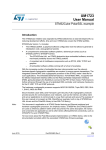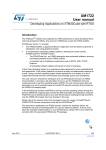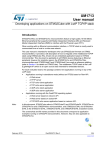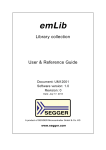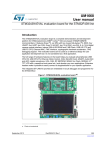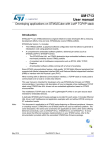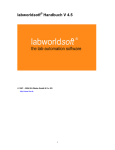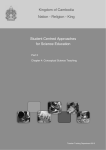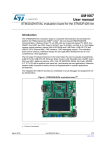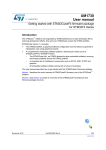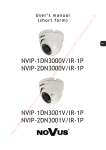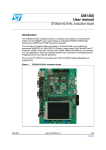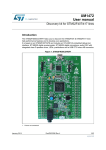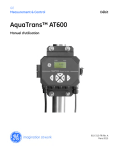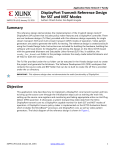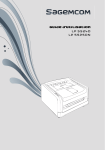Download STM32CubeF4 PolarSSL example
Transcript
UM1723 User Manual STM32CubeF4 PolarSSL example Introduction The STM32Cube™ initiative was originated by STMicroelectronics to ease developers life, by reducing development efforts, time and cost. STM32Cube™ covers the STM32 portfolio. STM32Cube™ Version 1.x includes: • The STM32CubeMX, a graphical software configuration tool that allows to generate C initialization code, using graphical wizards • A comprehensive embedded software platform, delivered per series (such as STM32CubeF4 for STM32F4 series) – The STM32Cube HAL, an STM32 abstraction layer embedded software, ensuring maximized portability across the STM32 portfolio – A consistent set of middleware components such as RTOS, USB, TCP/IP and graphics – All embedded software utilities coming with a full set of examples. STM32F4xx microcontrollers feature a complete 10/100 Mbit/s Ethernet peripheral that supports both the Media Independent Interface (MII) and Reduced Media Independent Interface (RMII) to interface with the Physical Layer (PHY), with hardware checksums of the IP, UDP, TCP and ICMP protocols. One of the advanced features of the STM32F4xx is the hardware cryptographic processor for AES/128/192/256, Triple DES, DES, SHA-1, SHA-2, MD5 and RNG. Secure Sockets Layer (SSL) and Transport Layer Security (TLS) cryptographic protocols provide security for communications over networks, such as the Internet, and allow client and server applications to communicate in a way that is private and secure.The purpose of this user manual is to present a demonstration package built on top of STM32Cube HAL drivers and the PolarSSL library (a free SSL/TLS library). This document is structured as follows: • A general introduction to SSL/TLS is presented in Chapter 2 • Chapter 3 introduces the PolarSSL library • Chapter 4 describes the STM32F417/F439 hardware cryptographic processors • Lastly, Chapter 5 describes the demonstration package for STM32F417/F439 microcontrollers Note: March 2014 In this document STM32F4xx refers to STM32F417 and STM32F439 microcontrollers; also the STM324xx-EVAL refers to the STM3241G-EVAL and the STM32439I-EVAL boards. DocID025805 Rev 1 1/30 www.st.com Contents UM1723 Contents 1 2 3 4 SSL / TLS protocol overview . . . . . . . . . . . . . . . . . . . . . . . . . . . . . . . . . . 6 1.1 History of the SSL / TLS protocols . . . . . . . . . . . . . . . . . . . . . . . . . . . . . . . 6 1.2 SSL / TLS application layers . . . . . . . . . . . . . . . . . . . . . . . . . . . . . . . . . . . 7 1.3 SSL / TLS sub-protocols . . . . . . . . . . . . . . . . . . . . . . . . . . . . . . . . . . . . . . 7 6 2/30 SSL Handshake protocol . . . . . . . . . . . . . . . . . . . . . . . . . . . . . . . . . . . . . 8 1.3.2 SSL Record protocol . . . . . . . . . . . . . . . . . . . . . . . . . . . . . . . . . . . . . . . 11 1.3.3 SSL Alert protocol . . . . . . . . . . . . . . . . . . . . . . . . . . . . . . . . . . . . . . . . . 12 1.3.4 Change Cipher Spec protocol . . . . . . . . . . . . . . . . . . . . . . . . . . . . . . . . 12 PolarSSL library . . . . . . . . . . . . . . . . . . . . . . . . . . . . . . . . . . . . . . . . . . . 13 2.1 Overview . . . . . . . . . . . . . . . . . . . . . . . . . . . . . . . . . . . . . . . . . . . . . . . . . 13 2.2 License . . . . . . . . . . . . . . . . . . . . . . . . . . . . . . . . . . . . . . . . . . . . . . . . . . . 13 STM32F4 hardware cryptography . . . . . . . . . . . . . . . . . . . . . . . . . . . . . 14 3.1 Cryptographic processor . . . . . . . . . . . . . . . . . . . . . . . . . . . . . . . . . . . . . 14 3.2 Random number generator . . . . . . . . . . . . . . . . . . . . . . . . . . . . . . . . . . . 14 3.3 Hash processor . . . . . . . . . . . . . . . . . . . . . . . . . . . . . . . . . . . . . . . . . . . . 14 Description of the package . . . . . . . . . . . . . . . . . . . . . . . . . . . . . . . . . . 15 4.1 Package directories . . . . . . . . . . . . . . . . . . . . . . . . . . . . . . . . . . . . . . . . . 15 4.2 Application settings . . . . . . . . . . . . . . . . . . . . . . . . . . . . . . . . . . . . . . . . . . 15 4.3 5 1.3.1 4.2.1 PHY interface configuration . . . . . . . . . . . . . . . . . . . . . . . . . . . . . . . . . . 15 4.2.2 MAC and IP address settings . . . . . . . . . . . . . . . . . . . . . . . . . . . . . . . . 16 Evaluation boards settings . . . . . . . . . . . . . . . . . . . . . . . . . . . . . . . . . . . . 16 4.3.1 STM324x9I-EVAL settings . . . . . . . . . . . . . . . . . . . . . . . . . . . . . . . . . . . 16 4.3.2 STM324xG-EVAL settings . . . . . . . . . . . . . . . . . . . . . . . . . . . . . . . . . . . 16 Using the applications . . . . . . . . . . . . . . . . . . . . . . . . . . . . . . . . . . . . . . 17 5.1 SSL client application . . . . . . . . . . . . . . . . . . . . . . . . . . . . . . . . . . . . . . . . 17 5.2 SSL server application . . . . . . . . . . . . . . . . . . . . . . . . . . . . . . . . . . . . . . . 20 Conclusion . . . . . . . . . . . . . . . . . . . . . . . . . . . . . . . . . . . . . . . . . . . . . . . . 25 DocID025805 Rev 1 UM1723 7 Contents FAQ . . . . . . . . . . . . . . . . . . . . . . . . . . . . . . . . . . . . . . . . . . . . . . . . . . . . . . 26 Appendix A Additional information. . . . . . . . . . . . . . . . . . . . . . . . . . . . . . . . . . . . 27 Revision history . . . . . . . . . . . . . . . . . . . . . . . . . . . . . . . . . . . . . . . . . . . . . . . . . . . . 29 DocID025805 Rev 1 3/30 3 List of tables UM1723 List of tables Table 1. Table 2. Table 3. 4/30 STM324x9I-EVAL jumper configurations . . . . . . . . . . . . . . . . . . . . . . . . . . . . . . . . . . . . . . 16 STM324xG-EVAL jumper configurations . . . . . . . . . . . . . . . . . . . . . . . . . . . . . . . . . . . . . . 16 Document revision history. . . . . . . . . . . . . . . . . . . . . . . . . . . . . . . . . . . . . . . . . . . . . . . . . . 29 DocID025805 Rev 1 UM1723 List of figures List of figures Figure 1. Figure 2. Figure 3. Figure 4. Figure 5. Figure 6. Figure 7. Figure 8. Figure 9. Figure 10. Figure 11. Figure 12. Figure 13. Figure 14. Figure 15. SSL application architecture . . . . . . . . . . . . . . . . . . . . . . . . . . . . . . . . . . . . . . . . . . . . . . . . . 7 SSL sub-protocols. . . . . . . . . . . . . . . . . . . . . . . . . . . . . . . . . . . . . . . . . . . . . . . . . . . . . . . . . 8 SSL Handshake protocol . . . . . . . . . . . . . . . . . . . . . . . . . . . . . . . . . . . . . . . . . . . . . . . . . . . 9 Handshake protocol to resume an SSL session . . . . . . . . . . . . . . . . . . . . . . . . . . . . . . . . . 11 SSL Record protocol. . . . . . . . . . . . . . . . . . . . . . . . . . . . . . . . . . . . . . . . . . . . . . . . . . . . . . 11 SSL client demonstration architecture . . . . . . . . . . . . . . . . . . . . . . . . . . . . . . . . . . . . . . . . 18 SSL client application . . . . . . . . . . . . . . . . . . . . . . . . . . . . . . . . . . . . . . . . . . . . . . . . . . . . . 19 The ssl_server application window . . . . . . . . . . . . . . . . . . . . . . . . . . . . . . . . . . . . . . . . . . . 19 HyperTerminal window . . . . . . . . . . . . . . . . . . . . . . . . . . . . . . . . . . . . . . . . . . . . . . . . . . . . 20 SSL server application architecture . . . . . . . . . . . . . . . . . . . . . . . . . . . . . . . . . . . . . . . . . . 21 The SSL server application. . . . . . . . . . . . . . . . . . . . . . . . . . . . . . . . . . . . . . . . . . . . . . . . . 22 HTML page displayed on successful connection . . . . . . . . . . . . . . . . . . . . . . . . . . . . . . . . 23 HyperTerminal SSL server connection status. . . . . . . . . . . . . . . . . . . . . . . . . . . . . . . . . . . 24 SSL client thread flowchart . . . . . . . . . . . . . . . . . . . . . . . . . . . . . . . . . . . . . . . . . . . . . . . . . 27 SSL server thread flowchart . . . . . . . . . . . . . . . . . . . . . . . . . . . . . . . . . . . . . . . . . . . . . . . . 28 DocID025805 Rev 1 5/30 5 SSL / TLS protocol overview 1 UM1723 SSL / TLS protocol overview The Secure Socket Layer (SSL) and Transport Layer Security (TLS) protocols provide communications security over the Internet and allow client/server applications to communicate in a way that is private and reliable. These protocols are layered above a transport protocol such as TCP/IP. SSL is the standard security technology for creating an encrypted link between server and client. This link ensures that all communication data remains private and secure. The major objectives of SSL/TLS are: • Provide data integrity between two communicating applications. • Protect information transmitted between server and client. • Authenticate the server to the client. • Allow the client and server to select the cryptographic algorithms that they both support. • Optionally authenticate the client to the server. • Use public-key encryption techniques to generate shared secrets. • Establish an encrypted SSL connection. 1.1 History of the SSL / TLS protocols SSL was developed by Netscape in 1994 to secure transactions over the Internet. Soon after, the Internet Engineering Task Force (IETF) began work to develop a standard protocol to provide the same functionality. • SSL 1.0 (Netscape, 1993): Internal Netscape design • SSL 2.0 (Netscape, 1994): This version contained a number of security flaws • SSL 3.0 (Netscape, 1996): All Internet browsers support this version of the protocol • TLS 1.0 (IETF, 1999): This version was defined in RFC 2246 as an upgrade to SSL 3.0 “The differences between this protocol and SSL 3.0 are not dramatic, but they are significant enough that TLS 1.0 and SSL 3.0 do not inter-operate” • TLS 1.1 (IETF, 2006): This version was defined in RFC 4346. It is an update from TLS version 1.0 • TLS 1.2 (IETF, 2008): This version was defined in RFC 5246. It is based on the earlier TLS 1.1 Note: 6/30 The “SSL/TLS” protocols are referred by “SSL” throughout this document. DocID025805 Rev 1 UM1723 1.2 SSL / TLS protocol overview SSL / TLS application layers An application using SSL / TLS protocol consists generally of five layers: • Application layer: the Application Layer refers to the higher-level protocols used by most applications for network communication • SSL/TLS layer: the SSL/TLS layer provides security communication over the Internet • TCP layer: the Transport Layer's responsibilities include end-to-end message transfer capabilities independent of the underlying network, along with error control, segmentation, flow control, congestion control, and application addressing • IP layer: the Internet Protocol layer is responsible for addressing hosts and routing packets from a source host to the destination host • Physical layer: the Physical Layer consists of the basic hardware transmission technologies of a network Figure 1. SSL application architecture $SSOLFDWLRQOD\HU 66/7/6OD\HU 7&3OD\HU ,3OD\HU 3K\VLFDOOD\HU 069 1.3 SSL / TLS sub-protocols The SSL / TLS protocol includes four sub-protocols: the SSL Record protocol, the SSL Handshake protocol, the SSL Alert protocol and the SSL Change Cipher Spec protocol. DocID025805 Rev 1 7/30 29 SSL / TLS protocol overview UM1723 Figure 2. SSL sub-protocols $SSOLFDWLRQ 66/76/ +DQGVKDNH &&6 $OHUW 5HFRUG 7&3,3 069 1.3.1 SSL Handshake protocol The SSL session state is controlled by the SSL Handshake protocol. This protocol involves using the SSL record protocol to exchange a series of messages between SSL server and SSL client when they first start communicating. This exchange of messages is designed to facilitate the following actions: • The protocol version • Allow the client and server to select the cryptographic algorithms, or ciphers, that they both support • Authenticate the server to the client • Optionally authenticate the client to the server • Use public-key encryption techniques to generate shared secrets • Establish an encrypted SSL connection 8/30 DocID025805 Rev 1 UM1723 SSL / TLS protocol overview Figure 3. SSL Handshake protocol The following is the procedure for SSL Handshake protocol: 1. 2. The client sends a ClientHello message specifying the highest SSL protocol version it supports, a random number, a list of cipher suites and compression methods Server responds with a ServerHello message that contains the chosen protocol version, another random number, cipher suite and compression method from the choices offered by the client, and the session ID DocID025805 Rev 1 9/30 29 SSL / TLS protocol overview UM1723 Note: The client and the server must support at least one common cipher suite, or else the Handshake protocol fails. The server generally chooses the strongest common cipher suite they both support. 3. The server sends its digital certificate in an optional certificate message, for example, the server uses X.509 digital certificates 4. If no certificate is sent, an optional ServerKeyExchange message is sent containing the server public information 5. If the server requires a digital certificate for client authentication, an optional CertificateRequest message is appended 6. The server sends a ServerHelloDone message indicating the end of this phase of negotiation 7. If the server has sent a CertificateRequest message, the client must send its X.509 client certificate in a Certificate message 8. The client sends a ClientKeyExchange message. This message contains the premaster secret number used in the generation of the symmetric encryption keys and the message authentication code (MAC) keys. The client encrypts pre-master secret number with the public key of the server Note: The public key is sent by the server in the digital certificate or in ServerKeyExchange message. 9. If the client sent a digital certificate to the server, the client sends a CertificateVerify message signed with the client's private key. By verifying the signature of this message, the server can explicitly verify the ownership of the client digital certificate 10. The client sends a ChangeCipherSpec message announcing that the new parameters (cipher method, keys) have been loaded 11. The client sends a finished message; it is the first message encrypted with the new cipher method and keys 12. The server responds with a ChangeCipherSpec and a finished message from its end 13. The SSL Handshake protocol ends and the encrypted exchange of application data can be started Resuming SSL session When the client and the server decide to resume a previous session or to duplicate an existing session (instead of negotiating new security parameters), the message flow is as follows: 1. The client sends a ClientHello message using the Session ID of the session to be resumed 2. The server checks its session cache for a match. If a match is found, and the server is willing to re-establish the connection under the specified session state, it sends a ServerHello message with the same Session ID value 3. Both client and server must send ChangeCipherSpec messages and proceed directly to the finished messages 4. Once the re-establishment is complete, the client and server may begin to exchange encrypted application data Note: 10/30 If a Session ID match is not found, the server generates a new session ID and the client and server perform a full Handshake protocol [1]: RFC 5246: The TLS protocol version 1.2. DocID025805 Rev 1 UM1723 SSL / TLS protocol overview Figure 4. Handshake protocol to resume an SSL session 1.3.2 SSL Record protocol The Record protocol takes messages to be transmitted, fragments the data into manageable blocks, optionally compresses the data, applies a MAC, encrypts, and transmits the results. The received data is decrypted, verified, decompressed, and reassembled, then delivered to higher level clients. Figure 5. SSL Record protocol $SSOLFDWLRQGDWD )UDJPHQW ) ) )Q &RPSUHVVLRQ $XWKHQWLILFDWLRQ (QFU\SWLRQ DocID025805 Rev 1 069 11/30 29 SSL / TLS protocol overview 1.3.3 UM1723 SSL Alert protocol The SSL Alert protocol signals problems with the SSL session ranging from simple warnings (unknown certificate, revoked certificate, expired certificate) to fatal error messages that immediately terminate the SSL connection. 1.3.4 Change Cipher Spec protocol The SSL Change Cipher Spec protocol consists of a single message that indicates the end of the SSL Handshake protocol. 12/30 DocID025805 Rev 1 UM1723 PolarSSL library 2 PolarSSL library 2.1 Overview PolarSSL is a light-weight open source cryptographic and SSL/TLS library written in C. This library contains all needed functions to implement an SSL/TLS server or client. It contains also a set of hashing functions and cryptographic algorithms. Library features: • SSL 3.0, TLS 1.0 TLS 1.1 and TLS 1.2 client/server support • Symmetric encryption algorithms: AES, Blowfish, Triple-DES (3DES), DES, ARC4, Camellia, XTEA • Modes of operation: ECB, CBC, CFB, CTR, GCM • Hash algorithms: MD2, MD4, MD5, SHA-1, SHA-224, SHA-256, SHA-384, SHA-512 • Software random number generator: HAVEGE, CTR-DRBG • X509 certificates, CRLs, Keys and ASN.1 • Public key cryptography: RSA and Diffie-Hellman (DHM) key exchange The source code of the PolarSSL library can be downloaded from this link: http://polarssl.org/ 2.2 License PolarSSL is licensed according to the dual licensing model. PolarSSL is available under the open source GPL version two license, as well as under a commercial license for closed source projects. For detailed information about licensing, please refer to this link: https://polarssl.org/ DocID025805 Rev 1 13/30 29 STM32F4 hardware cryptography 3 UM1723 STM32F4 hardware cryptography As described in Chapter 2: PolarSSL library, the PolarSSL library contains a set of symmetric encryption algorithms (AES 128/192/256, Triple DES), hashing functions (MD5, SHA-1, SHA-2) and a software random number generator. All these functions and algorithms are needed to implement SSL/TLS applications. To off-load the CPU from encryption/decryption, hash and RNG (random number generator) tasks, all these functions and algorithms are implemented using the hardware acceleration AES 128/192/256, Triple DES, MD5, SHA-1, SHA-2 and analog RNG through the STM32Cube HAL APIs. 3.1 Cryptographic processor The cryptographic processor can be used to both encipher and decipher data using the Triple-DES or AES algorithm. It is a fully compliant implementation of the following standards: • The data encryption standard (DES) and Triple-DES (TDES) as defined by the Federal Information Processing Standards Publication “FIPS PUB 46-3, 1999 October 25”. It follows the American National Standards Institute (ANSI) X9.52 standard • The advanced encryption standard (AES) as defined by Federal Information Processing Standards Publication “FIPS PUB 197, 2001 November 26” The CRYP processor may be used for both encryption and decryption in the Electronic codebook (ECB) mode, the Cipher block chaining (CBC) mode or the Counter (CTR) mode (in AES only). 3.2 Random number generator The RNG processor is a random number generator based on a continuous analog noise that provides a random 32-bit value to the host when read. 3.3 Hash processor The hash processor is a fully compliant implementation of the SHA (secure hash algorithm), the (message-digest algorithm 5) hash algorithm and the HMAC (keyed-hash message authentication code) algorithm suitable for a variety of applications.It computes a message digest (160 bits for the SHA-1 algorithm, 256 bits for the SHA-256 algorithm and 224 bits for the SHA-224 algorithm,128 bits for the MD5 algorithm) for messages of up to (2^64 - 1) bits, while HMAC algorithms provide a way of authenticating messages by means of hash functions. HMAC algorithms consist in calling the SHA-1, SHA-224, SHA-256 or MD5 hash function twice. Note: 14/30 For more detailed information, please refer to the CRYP, HASH and RNG sections of: RM0090: STM32F405xx/07xx, STM32F415xx/17xx, STM32F42xxx and STM32F43xxx advanced ARM-based 32-bit MCUs DocID025805 Rev 1 UM1723 4 Description of the package Description of the package This package contains two applications running on top of the PolarSSL library and LwIP stack in RTOS mode: • • 4.1 SSL Client: This application proves the ability of the STM32F4xx device to exchange messages with a server over TCP/IP connectivity through a SSL connection. This application allows you to connect the STM324xx-EVAL board to a secure web server with SSL protocol SSL server: This application is a combination of HTTP with SSL protocol to provide encryption and secure identification of the server. This application allows you to connect from a web browser to a STM324xx-EVAL board using SSL protocol Package directories The package contains a two applications running on top of PolarSSL, LwIP, FreeRTOS and STM32F4Cube HAL and BSP drivers. The firmware is composed from the following modules: • Drivers: contains the SMT32Cube drivers of the MCU – CMSIS – BSP drivers – HAL drivers • Middleware: contains libraries and protocol components – LwIP TCP/IP stack – PolarSSL library – FreeRTOS • Projects: contains the source file and configurations of each application 4.2 Application settings 4.2.1 PHY interface configuration The Ethernet peripheral is interfaced with an external PHY to provide physical layer communication. The PHY registers definition and defines are located under the HAL configuration file “stm32f4xx_hal_conf.h”. The PHY operates following two modes MII and RMII; to select the required mode user has to fill the “MediaInterface” parameter of “Init” structure when initializing the Ethernet peripheral. Note: The RMII mode is not supported when using the STM32439I-EVAL board. In the RMII mode with STM3241G-EVAL, you have to provide the 50 MHz clock by soldering a 50 MHz oscillator (ref SM7745HEV-50.0M or equivalent) on the U3 footprint located under CN3 and also by removing the jumper from JP5. This oscillator is not provided with the board. DocID025805 Rev 1 15/30 29 Description of the package 4.2.2 UM1723 MAC and IP address settings The default MAC address is set to: 00:00:00:00:00:02. To change this address, modify the six bytes defined in the stm32f4xx_hal_conf.h file. The default IP address is set to: 192.168.0.10. To change this address, modify the six bytes defined in the main.h file. 4.3 Evaluation boards settings 4.3.1 STM324x9I-EVAL settings To run the software on the STM324x9I-EVAL board, configure it as shown in Table 1. Table 1. STM324x9I-EVAL jumper configurations Jumper JP6 4.3.2 MII mode configuration 1-2: provide 25 MHz clock by external crystal 2-3: provide 25 MHz clock by MCO at PA8 STM324xG-EVAL settings To run the software on the STM324xG-EVAL board, configure it as shown in Table 2. Table 2. STM324xG-EVAL jumper configurations Jumper 16/30 MII mode configuration RMII mode configuration JP5 1-2: provide 25 MHz clock by external crystal Not fitted 2-3: provide 25 MHz clock by MCO at PA8 JP6 2-3: MII interface mode is enabled. 1-2: RMII interface mode is enabled. JP8 Open: MII interface mode is selected. Closed: RMII interface mode is selected. DocID025805 Rev 1 UM1723 Using the applications 5 Using the applications 5.1 SSL client application This demonstration consists of using the STM3241G-EVAL or the STM32439I-EVAL board as a client that connects to a secure server to provide the SSL Handshake protocol. Architecture of the application The SSL client demonstration as shown in Figure 6 contains five threads: • LED task: Blink LED4 every 200 ms. • Ethernet input thread: The low-level layer was set to detect the reception of frames by interrupts. So, when the Ethernet controller receives a valid frame, it generates an interrupt. In the handling function of this interrupt, a binary semaphore is created to wake up the Ethernet task. This task transfers the input frames to the TCP/IP stack. • Ethernet link thread: handles Ethernet cable connection and disconnection process • TCP/IP thread: All packet processing (input and output) is done inside this thread. The application threads communicate with this thread using message boxes and semaphores. • SSL client thread: This task handles the SSL Handshake protocol. It connects to an SSL server and performs the following: – Initializes SSL structures (SSL context, SSL session, SSL RNG) – Connects to a SSL server – Sets up the SSL session – Handles the SSL Handshake protocol – Writes a message to the server – Reads a message from the server – Sends these messages through USART – Closes the connection – Cleans all SSL structures DocID025805 Rev 1 17/30 29 Using the applications UM1723 Figure 6. SSL client demonstration architecture ^^>ĐůŝĞŶƚƚŚƌĞĂĚ ^^>ĐůŝĞŶƚƚŚƌĞĂĚ WŽůĂƌ^^> WŽůĂƌ^^> ^^>ͬd>^ ^^>ͬd>^ dWͲ/WdŚƌĞĂĚ dWͲ/WdŚƌĞĂĚ &ƌĞĞZdK^ &ƌĞĞZdK^ >ǁ/W >ǁ/W ƚŚĞƌŶĞƚdŚƌĞĂĚ ƚŚĞƌŶĞƚdŚƌĞĂĚ ^dDϯϮƵďĞ>ŝďƌĂƌLJ ^dDϯϮƵďĞ>ŝďƌĂƌLJ 069 How to use the application First, connect the STM324xx-EVAL board as follows: • • Ethernet link: Connect to a remote PC (through a crossover Ethernet cable) or to your local network (through a straight Ethernet cable) RS232 link (used with HyperTerminal like application to display debug messages): Connect a null-modem female/female RS232 cable between the USART connector of the STM324xx -EVAL board and the PC serial port To run the SSL client example, please proceed as follows: • Build and program the SSL client code in the STM32F4xx Flash • Run the SSL server application on the remote PC, and run “ssl_server.exe“ under Utilities\PC_Software\ssl_server. This application then waits for a client connection on https port 443 • Start the STM324xx -EVAL board • Monitor the connection status in the SSL server application window and HyperTerminal window Note: 18/30 Please ensure that the remote PC IP address is the same address as defined in “ssl_client.c” file (#define SSL_SERVER_NAME “192.168.0.1”). If a firewall is used, user must be sure that the “ssl_server” application accepts connection requests. If it does not, the firewall will reject the client requests. DocID025805 Rev 1 UM1723 Using the applications Figure 7. SSL client application The ssl_server.exe application window is shown in Figure 8. The SSL server application displays the connection request status; all exchange messages between the server and the client are displayed. Figure 8. The ssl_server application window DocID025805 Rev 1 19/30 29 Using the applications UM1723 HyperTerminal HyperTerminal window (Figure 9) displays the status of the SSL client application running on the STM32F4xx device (write messages and read messages): • Status of SSL structures (SSL context, SSL session, SSL RNG) • Client request to the server: “GET” • The received message contains the result of Handshake protocol: for example “Successful connection using: SSL_EDH_RSA_AES_256_SHA”. Figure 9. HyperTerminal window 5.2 SSL server application This demonstration consists of setting up the STM32 as an SSL server that waits for a SSL client request to make the connection. Architecture of the application The SSL server demonstration contains six threads: The LED, Ethernet input, Ethernet link, and TCP_IP thread are the same as the SSL client application threads. SSL server thread: This thread creates an SSL connection and waits for the client's request to make the secure connection. When the connection is established, the client sends Get request to load the html page. This page contains information about the tasks running in this demonstration. The SSL server task also sends the status of the connection through USART. DHCP_Client thread: This thread is used to configure the IP address by DHCP. To enable the DHCP client, uncomment the define USE_DHCP in main.h file. 20/30 DocID025805 Rev 1 UM1723 Using the applications Figure 10. SSL server application architecture ^^>ĐůŝĞŶƚƚŚƌĞĂĚ ^^>ĐůŝĞŶƚƚŚƌĞĂĚ WŽůĂƌ^^> WŽůĂƌ^^> ^^>ͬd>^ ^^>ͬd>^ dWͲ/WdŚƌĞĂĚ dWͲ/WdŚƌĞĂĚ &ƌĞĞZdK^ &ƌĞĞZdK^ >ǁ/W >ǁ/W ƚŚĞƌŶĞƚdŚƌĞĂĚ ƚŚĞƌŶĞƚdŚƌĞĂĚ ^dDϯϮƵďĞ>ŝďƌĂƌLJ ^dDϯϮƵďĞ>ŝďƌĂƌLJ 069 How to use the application First, connect the STM324xx-EVAL board as follows: • Ethernet link: Connect to a remote PC (through a crossover Ethernet cable) or to your local network (through a straight Ethernet cable) • RS232 link (used with HyperTerminal-like application to display debug messages): To run the SSL server demonstration: • Build and program the SSL server code in the STM32F4xx Flash • Start the STM324xx-EVAL board • Open a web browser such as Internet Explorer or Firefox, and type https:// followed by the board's IP address in the browser, by default type “https//192.168.0.10” Note: If a firewall is present, user must be sure that the HTTPS port accepts the connection requests. If it does not, the firewall will reject the connection. DocID025805 Rev 1 21/30 29 Using the applications UM1723 Figure 11. The SSL server application On successful connection, a page is displayed showing the running tasks and their status. This page contains also the number of page hits and the list of cipher suites used in the connection. 22/30 DocID025805 Rev 1 UM1723 Using the applications Figure 12. HTML page displayed on successful connection DocID025805 Rev 1 23/30 29 Using the applications UM1723 You can monitor the connection status of the SSL server application running on STM32F4xx device, using the HyperTerminal window. This window (Figure 13) shows: • The status of connection, SSL structures and Handshake protocol • The size of the client's request message • The size of the server's response (html page) Figure 13. HyperTerminal SSL server connection status Note: 24/30 The first time you connect to the server, you receive a warning message from the browser about the certificate presented. This warning occurs when the certificate has been issued by a certification authority (CA) that is not recognized by the browser or when the certificate was issued to a different web address. DocID025805 Rev 1 UM1723 6 Conclusion Conclusion This user manual describes two STM32F4xx applications that implement the PolarSSL library with the STM32Cube drivers. The first one demonstrates the ability of the STM32F4xx devices to exchange messages with a server through an SSL connection. This application allows the STM32 to connect to a secure web server. The second one is a combination of HTTP with SSL protocol to provide encryption and secure identification of the server. This application allows the user to connect to an STM32 using the SSL protocol from a web browser. DocID025805 Rev 1 25/30 29 FAQ 7 UM1723 FAQ How to choose between static or dynamic (DHCP) IP address allocation? When the macro #define USE_DHCP located in “main.h” is commented, a static IP address is assigned to the STM32 microcontroller (by default 192.168.0.10, this value can be modified from “main.h” file). If the macro #define USE_DHCP is uncommented, the DHCP protocol is enabled, and the STM32 will act as a DHCP client How the application behaves when the Ethernet cable is disconnected? When the cable is disconnected the Ethernet peripheral stops both transmission and reception traffics, also the network interface will be set down. If an LCD controller is used a message is displayed to inform user that the cable is not connected, else the Red LED of the evaluation board will turn on. When the user re-connects the cable, the Ethernet traffic will resume and network interface will be set up. If an LCD controller is used a message is displayed to inform user the new IP address either with static or dynamic allocation, else the Yellow LED of the evaluation board will turn on. How to port the application on a different hardware? When another hardware platform is used, you have to check the GPIO configuration into the HAL_ETH_MspInit() function for the Ethernet peripheral, also HAL_PPP_MspInit() or HAL_MspInit() if the application needs more PPP peripheral. 26/30 DocID025805 Rev 1 UM1723 Appendix A Additional information Additional information Figure 14. SSL client thread flowchart 6WDUW P HPVHW $OORFDWHDOO0HPRU\ EXI KDYHJH B LQLW ,QLWLDOL]HWKH51*DQGWKH VHVVLRQGDWD UHW QHW B FRQQHFW 6WDUWWKHFRQQHFWLRQ QR UHW \HV UHW VVO B LQLW ,QLWLDOL]HDQ66/FRQWH[W UHW QR \HV UHW VVO B ZULWH 6HQG DSSOLFDWLRQGDWD UHW! QR \HV UHW VVO B UHDG 5HDGWKH+773UHVSRQVH QHW B FORVH &ORVHWKH FRQQHFWLRQ VVO B IUHH &OHDQXSDOOPHPRU\ (QG DocID025805 Rev 1 069 27/30 29 Additional information UM1723 Figure 15. SSL server thread flowchart 6WDUW /RDGWKHFHUWLILFDWH %LQGRQKWWSVSRUW :DLWXQWLODFOLHQWFRQQHFWV QR &OLHQW FRQQHFWV \HV ,QLWLDOL]HWKH51*DQGWKH VHVVLRQGDWD UHW VVOB KDQGVKDNH +DQGVKDNHSURWRFRO UHW QR \HV UHW VVOB UHDG 5HDGWKH+7735HTXHVW UHW! QR \HV UHW VVOB ZULWH :ULWHWKHUHVSRQVH QHWB FORVH &ORVHWKHFRQQHFWLRQ VVOB IUHH &OHDQXSDOOPHPRU\ (QG 069 28/30 DocID025805 Rev 1 UM1723 Revision history Revision history Table 3. Document revision history Date Revision 27-Mar-2014 1 Changes Initial release. DocID025805 Rev 1 29/30 29 UM1723 Please Read Carefully: Information in this document is provided solely in connection with ST products. STMicroelectronics NV and its subsidiaries (“ST”) reserve the right to make changes, corrections, modifications or improvements, to this document, and the products and services described herein at any time, without notice. All ST products are sold pursuant to ST’s terms and conditions of sale. Purchasers are solely responsible for the choice, selection and use of the ST products and services described herein, and ST assumes no liability whatsoever relating to the choice, selection or use of the ST products and services described herein. No license, express or implied, by estoppel or otherwise, to any intellectual property rights is granted under this document. If any part of this document refers to any third party products or services it shall not be deemed a license grant by ST for the use of such third party products or services, or any intellectual property contained therein or considered as a warranty covering the use in any manner whatsoever of such third party products or services or any intellectual property contained therein. UNLESS OTHERWISE SET FORTH IN ST’S TERMS AND CONDITIONS OF SALE ST DISCLAIMS ANY EXPRESS OR IMPLIED WARRANTY WITH RESPECT TO THE USE AND/OR SALE OF ST PRODUCTS INCLUDING WITHOUT LIMITATION IMPLIED WARRANTIES OF MERCHANTABILITY, FITNESS FOR A PARTICULAR PURPOSE (AND THEIR EQUIVALENTS UNDER THE LAWS OF ANY JURISDICTION), OR INFRINGEMENT OF ANY PATENT, COPYRIGHT OR OTHER INTELLECTUAL PROPERTY RIGHT. ST PRODUCTS ARE NOT DESIGNED OR AUTHORIZED FOR USE IN: (A) SAFETY CRITICAL APPLICATIONS SUCH AS LIFE SUPPORTING, ACTIVE IMPLANTED DEVICES OR SYSTEMS WITH PRODUCT FUNCTIONAL SAFETY REQUIREMENTS; (B) AERONAUTIC APPLICATIONS; (C) AUTOMOTIVE APPLICATIONS OR ENVIRONMENTS, AND/OR (D) AEROSPACE APPLICATIONS OR ENVIRONMENTS. WHERE ST PRODUCTS ARE NOT DESIGNED FOR SUCH USE, THE PURCHASER SHALL USE PRODUCTS AT PURCHASER’S SOLE RISK, EVEN IF ST HAS BEEN INFORMED IN WRITING OF SUCH USAGE, UNLESS A PRODUCT IS EXPRESSLY DESIGNATED BY ST AS BEING INTENDED FOR “AUTOMOTIVE, AUTOMOTIVE SAFETY OR MEDICAL” INDUSTRY DOMAINS ACCORDING TO ST PRODUCT DESIGN SPECIFICATIONS. PRODUCTS FORMALLY ESCC, QML OR JAN QUALIFIED ARE DEEMED SUITABLE FOR USE IN AEROSPACE BY THE CORRESPONDING GOVERNMENTAL AGENCY. Resale of ST products with provisions different from the statements and/or technical features set forth in this document shall immediately void any warranty granted by ST for the ST product or service described herein and shall not create or extend in any manner whatsoever, any liability of ST. ST and the ST logo are trademarks or registered trademarks of ST in various countries. Information in this document supersedes and replaces all information previously supplied. The ST logo is a registered trademark of STMicroelectronics. All other names are the property of their respective owners. © 2014 STMicroelectronics - All rights reserved STMicroelectronics group of companies Australia - Belgium - Brazil - Canada - China - Czech Republic - Finland - France - Germany - Hong Kong - India - Israel - Italy - Japan Malaysia - Malta - Morocco - Philippines - Singapore - Spain - Sweden - Switzerland - United Kingdom - United States of America www.st.com 30/30 DocID025805 Rev 1






























